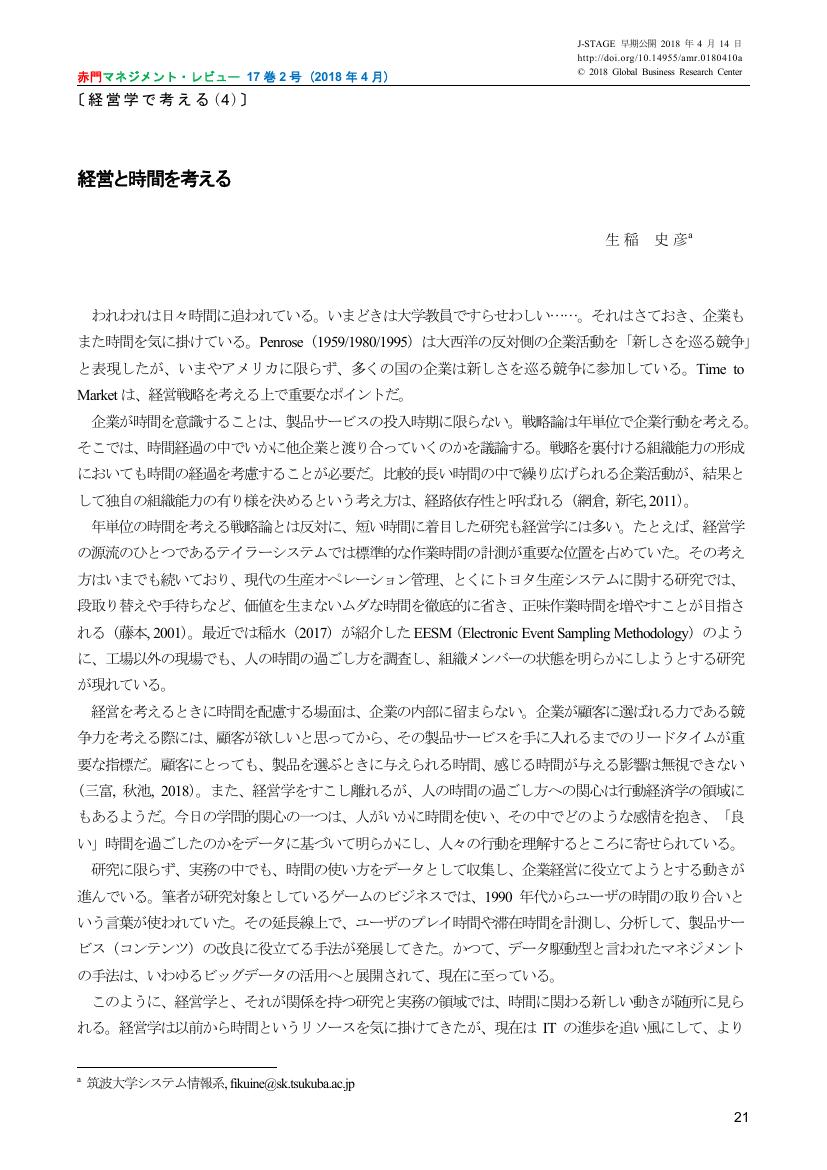5 0 0 0 OA 組織の〈重さ〉と組織の諸特性:日本企業における組織劣化現象と組織デザイン
- 著者
- 沼上 幹 軽部 大 田中 一弘 島本 実 加藤 俊彦 生稲 史彦
- 出版者
- 特定非営利活動法人 組織学会
- 雑誌
- 組織科学 (ISSN:02869713)
- 巻号頁・発行日
- vol.39, no.4, pp.12-26, 2006-06-20 (Released:2022-08-05)
- 参考文献数
- 18
本論文は,データ・リッチな実証研究を行なうためのコンソーシアムを形成して行なわれている,組織の 重さ プロジェクトの主要な知見を紹介する.コンソーシアムに参加した企業のBUに関しては,内部調整に約4割の時間が割かれていること,また比較的容易に調整が達成できる組織は有機的組織の特徴と機械的組織の特徴を両方備えていることが明らかにされる.
4 0 0 0 OA コンテンツ産業の政策制度設計
- 著者
- 生稲 史彦 原 泰史
- 出版者
- 特定非営利活動法人 組織学会
- 雑誌
- 組織学会大会論文集 (ISSN:21868530)
- 巻号頁・発行日
- vol.4, no.1, pp.52-58, 2015-07-31 (Released:2015-07-31)
- 参考文献数
- 14
Japanese animation industry has a big contradiction. Despite they have made great honorable animation, animators (people who draws motion picture) cannot get enough wages. Why their work are not adequately rewarded even they have a capability to produce excellent work? Involved stakeholders, academic researchers, and policy makes have shared similar concerns on this issue. Several policies had been implemented but it doesn’t yield sufficient outcomes. “Anime Mirai” policy is the new policy approach to solve this problem. Anime Mirai was planned mainly by the Japan Animation Creators Association (JAniCA), and implemented by the Agency for Cultural Affairs. Through Anime Mirai, policy makers aimed to develop human resources which sustain the creation of Japanese animation ecosystem. JAniCA and Cultural Affairs has same point of view on Japanese animation that current animation company haven’t capability to train young animators. In Anime Mirai scheme, JAniCA provided fund to the selected animation companies, these companies produced the new original animations to train young animators. Through Anime Mirai process, turn-over rate of young animators turns low and animation companies has own profitable copyright product such as Little Witch Academia (Trigger) and Death Parade(Madhouse). As of the policy implication of Anime Mirai, organizational failure could be absorbed by “gemba-oriented” governmental funding scheme.
2 0 0 0 OA 覇権・成熟・成長期におけるコミュニケーション・プラットフォームの競争戦略
- 著者
- 一小路 武安 勝又 壮太郎 中野 暁 山口 真一 生稲 史彦
- 出版者
- 特定非営利活動法人 組織学会
- 雑誌
- 組織科学 (ISSN:02869713)
- 巻号頁・発行日
- vol.55, no.3, pp.34-48, 2022-03-20 (Released:2022-04-20)
- 参考文献数
- 53
本研究ではコミュニケーションプラットフォームアプリの製品段階ごとの戦略を検討した.Latent Dirichlet Allocationの併用状態を明らかにしたうえで,機能や用途のような属性も踏まえてアプリを整理し,同じバスケット内の補完関係を精緻化して議論を行った.結果として覇権アプリでは機能的・性質的な補完,成熟・成長アプリでは用途的補完に加えて成熟に至る過程における関係するアプリの切り替えの可能性が示された.
2 0 0 0 OA 消費者インサイトの獲得
- 著者
- 水野 誠 生稲 史彦
- 出版者
- 特定非営利活動法人 グローバルビジネスリサーチセンター
- 雑誌
- 赤門マネジメント・レビュー (ISSN:13485504)
- 巻号頁・発行日
- vol.10, no.6, pp.441-462, 2011-10-26 (Released:2017-10-10)
- 参考文献数
- 12
世界的に有名なクリエイティブ・エージェンシーであるワイデン・ケネディの東京オフィスで5人のクリエイターとプランナーにインタビューを行い、彼らの仕事のスタイルや消費者インサイトを獲得する方法について聴いた。その結果は、社内における異質性を前提としたコラボレーション、消費者理解のための現場の取材や観察、それに基づくメンタル・シミュレーション、社外の人々との公的・私的なネットワーキング活動が重要であることを示している。
1 0 0 0 OA 産業別にみた企業のデータ活用能力と事業成果の関係についての実態調査
- 著者
- 立本 博文 平井 祐理 生稲 史彦
- 出版者
- 研究・イノベーション学会
- 雑誌
- 研究 技術 計画 (ISSN:09147020)
- 巻号頁・発行日
- vol.36, no.1, pp.5-16, 2021-06-30 (Released:2021-07-02)
- 参考文献数
- 9
This paper investigates the impact of big data on the business performances of Japanese companies by using the dataset of the questionnaire surveys conducted by RIETI in 2017 and 2020. There are three key findings.First, the companies that benefit from big data have not been significantly increasing. But the majority of the companies expect to expand their data use in the future. The fact indicates that the base of data utilization in Japan is growing with expectation.Second, measuring companies' data capability by data analytics competency (DAC) scores, we found the difference between manufacturing and service sectors. The DAC's effect in the service sector is statistically positive, whereas that in the manufacturing sector is not. This suggests that the benefit of data utilization is much evident in the service sector than that in the manufacturing sector.Third, by plotting the DAC scores of each sector on the data capability map, we found out the similarity and superiority among sectors. From the map, financial and information sectors have similar data competencies and relatively superior to other sectors in the light of data utilization.This study gives a good starting point for future research on sector comparison of the impact of big data and firms' capacity of data utilization.
1 0 0 0 OA デジタルコンテンツの製品開発組織とそのパフォーマンス
- 著者
- 生稲 史彦
- 出版者
- 特定非営利活動法人 グローバルビジネスリサーチセンター
- 雑誌
- 赤門マネジメント・レビュー (ISSN:13485504)
- 巻号頁・発行日
- vol.1, no.1, pp.33-66, 2002-04-25 (Released:2018-03-20)
- 参考文献数
- 28
本研究では、アンケート調査と売上データを用いた分析によって、どのような企業がデジタルコンテンツ(ゲームソフト市場)で効果的な製品開発を行い、高い企業成果をあげうるのかが検討されている。デジタルコンテンツの製品開発では、個人の能力・クリエイティビティが脚光を浴び、取り上げられることが多い。だが、分析の結果によると、ゲームソフトでも一定の範囲内の製品では、従来製造業などで見られたように、組織的な開発ノウハウの蓄積・活用が有効であり、高い成果に結びつくことが示されている。
1 0 0 0 消費者インサイトの獲得:あるクリエイティブ・エージェンシーの事例
- 著者
- 水野 誠 生稲 史彦
- 出版者
- 特定非営利活動法人 グローバルビジネスリサーチセンター
- 雑誌
- AMR (ISSN:13485504)
- 巻号頁・発行日
- vol.10, no.6, pp.441-462, 2011
<p>世界的に有名なクリエイティブ・エージェンシーであるワイデン・ケネディの東京オフィスで5人のクリエイターとプランナーにインタビューを行い、彼らの仕事のスタイルや消費者インサイトを獲得する方法について聴いた。その結果は、社内における異質性を前提としたコラボレーション、消費者理解のための現場の取材や観察、それに基づくメンタル・シミュレーション、社外の人々との公的・私的なネットワーキング活動が重要であることを示している。</p>
1 0 0 0 OA 経営と時間を考える
- 著者
- 生稲 史彦
- 出版者
- 特定非営利活動法人 グローバルビジネスリサーチセンター
- 雑誌
- 赤門マネジメント・レビュー (ISSN:13485504)
- 巻号頁・発行日
- vol.17, no.2, pp.21-24, 2018-04-25 (Released:2018-04-25)
- 参考文献数
- 5
1 0 0 0 エンターテイメント産業における企業家史--任天堂・山内溥氏の事例
- 著者
- 島田 昌和 生稲 史彦
- 出版者
- 文京学院大学総合研究所
- 雑誌
- 文京学院大学総合研究所紀要
- 巻号頁・発行日
- no.8, pp.53-71, 2007-12
